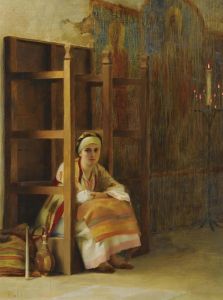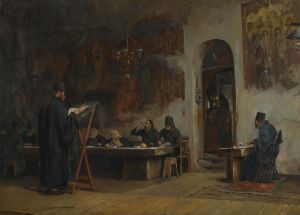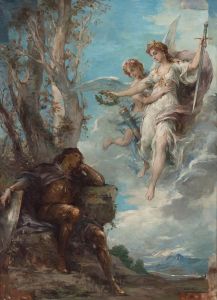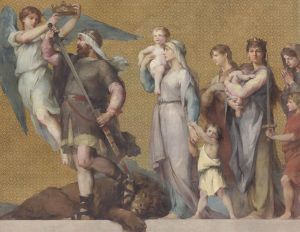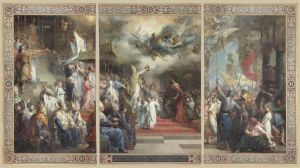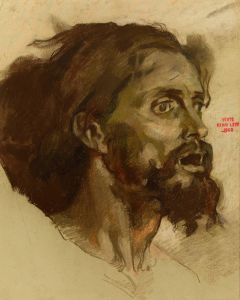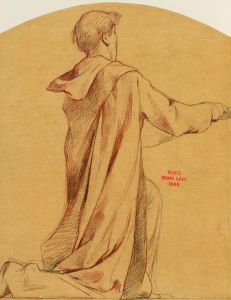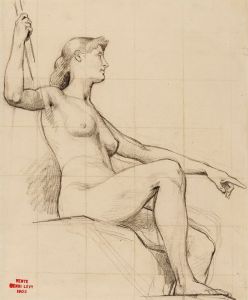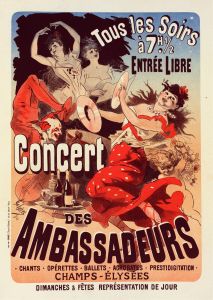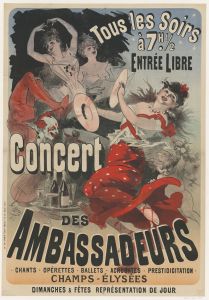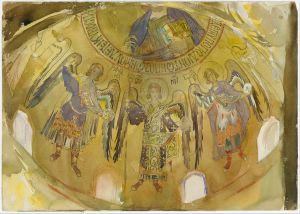
Les ambassadeurs de Haroun al Rashid offrent les clefs du Saint Sépulcre à Charlemagne
A hand-painted replica of Henri Leopold Lévy’s masterpiece Les ambassadeurs de Haroun al Rashid offrent les clefs du Saint Sépulcre à Charlemagne, meticulously crafted by professional artists to capture the true essence of the original. Each piece is created with museum-quality canvas and rare mineral pigments, carefully painted by experienced artists with delicate brushstrokes and rich, layered colors to perfectly recreate the texture of the original artwork. Unlike machine-printed reproductions, this hand-painted version brings the painting to life, infused with the artist’s emotions and skill in every stroke. Whether for personal collection or home decoration, it instantly elevates the artistic atmosphere of any space.
Henri Leopold Lévy's painting "Les ambassadeurs de Haroun al Rashid offrent les clefs du Saint Sépulcre à Charlemagne" is a notable work that captures a legendary moment in medieval history. Lévy, a French painter born in 1840 and active during the late 19th century, was known for his historical and religious subjects. This particular painting is an artistic representation of a legendary diplomatic exchange between the Abbasid Caliph Harun al-Rashid and the Frankish Emperor Charlemagne.
The painting depicts the moment when ambassadors from Harun al-Rashid, the fifth Abbasid Caliph who reigned from 786 to 809, present the keys to the Church of the Holy Sepulchre to Charlemagne, who was crowned Emperor of the Romans in 800. The Church of the Holy Sepulchre, located in Jerusalem, is one of Christianity's holiest sites, believed to be the location of Jesus Christ's crucifixion, burial, and resurrection.
This event, while legendary, symbolizes the diplomatic and cultural exchanges between the Islamic and Christian worlds during the early Middle Ages. Historical records suggest that Charlemagne and Harun al-Rashid exchanged gifts and envoys, reflecting a period of mutual respect and cooperation despite the broader context of religious and military conflicts between Christian Europe and the Islamic world. The exchange of the keys, though not definitively documented as a historical fact, represents the spirit of these interactions.
Lévy's painting captures the grandeur and significance of this moment with a focus on the figures of the ambassadors and Charlemagne. The composition likely emphasizes the opulence and ceremonial nature of the exchange, with attention to the attire and expressions of the figures involved. Such artistic choices would have been intended to convey the importance of the event and the stature of the individuals depicted.
The painting serves as a reflection of 19th-century European interest in medieval history and the romanticization of historical events. During this period, there was a fascination with the Middle Ages, often seen through a lens of chivalry and grand narratives. Lévy's work fits within this context, offering a visual interpretation that aligns with contemporary tastes and historical imagination.
While the painting itself is a product of artistic interpretation, it provides insight into how 19th-century artists and audiences viewed the past and the interactions between different cultures and religions. It stands as a testament to the enduring legacy of historical legends and their ability to inspire art and storytelling across centuries.
In summary, "Les ambassadeurs de Haroun al Rashid offrent les clefs du Saint Sépulcre à Charlemagne" by Henri Leopold Lévy is an artistic representation of a legendary diplomatic exchange between two significant historical figures. While the event itself may not be firmly rooted in historical fact, the painting captures the essence of cultural and diplomatic interactions during the early Middle Ages and reflects 19th-century European artistic and historical interests.





